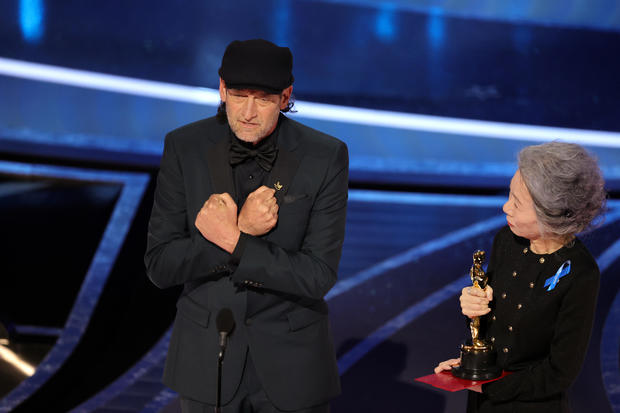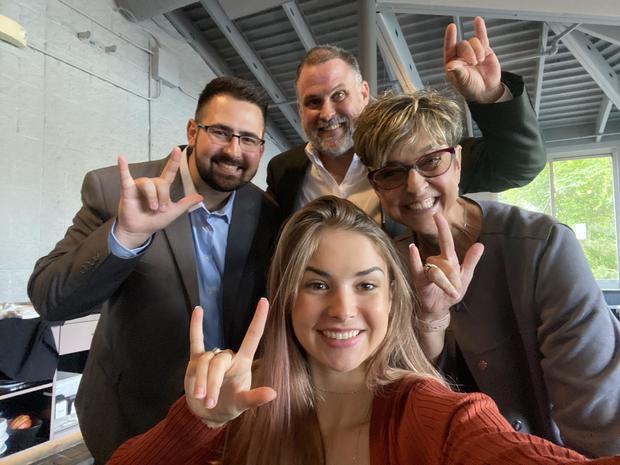Troy Kotsur was stunned by what he saw when he went up on stage to accept the Oscar for best supporting actor earlier this spring. The audience was a sea of waving hands.
“They were doing the Deaf clap — the Deaf applause,” he signed in ASL during an interview with CBS News. “It seemed like they were sharing this mutual respect and this hellish, tough journey I’ve been on for over 30 years.”
Getty Images
Kotsur’s win was one of three for the film “CODA” that night, along with best picture and best adapted screenplay. It also marked a historic milestone for the Deaf community since co-star Marlee Matlin won the best actress Oscar for her role in “Children of a Lesser God” — 35 years ago.
“‘CODA’ just happened to be the right director, the right support, like Marlee and [director] Sian [Heder]. They really believed in bringing that authenticity to the big screen onto the big screen,” he told CBS News. “Finally, we were able to show ourselves as authentic Deaf actors.”
The title, “CODA,” is an acronym for Child of Deaf Adults. The film tells a coming-of-age story about a hearing teenager (played by Emilia Jones) who is her Deaf family’s link to the hearing world — torn between family responsibilities and pursuit of her newfound love of singing. Kotsur and Matlin play the parents while Daniel Durant plays the older brother.
The portrayals resonated with some real-life CODAs, even when their personal experiences differed.
Kaitlin Sommer, a CODA and student at Rochester Institute of Technology, told CBS News she never felt that it was her responsibility to interpret for her Deaf parents. That was intentional, says her mother, Lisa DeWindt-Sommer, an academic advisor at the National Technical Institute for the Deaf.
Kaitlin Sommer
“The kids sometimes wanted to,” DeWindt-Sommer signed, referring to daughter Kaitlin and son Keiran. “And it was a challenge for us to remind them that it wasn’t their responsibility to interpret, but rather the hearing person’s responsibility to figure out how to communicate with us.”
She also points out another distinction: CODA, with a “C,” actually stands for children of Deaf parents who are 18 and older, while KODA, with a “K,” is reserved for kids under 18 — stressing the fact that kids should be kids.
“When I’m going to school and interacting with the school, I always push hard to make sure that they’re not expecting my child to be the interpreter,” she adds. “Because my child is a child.”
The inclusion of Deaf culture in education is key, she says. Hanging a poster with the alphabet in American Sign Language in the classroom is one way to embrace that.
“For young children with Deaf parents, it’s really great to create resources so that they can see a representation of themselves and their culture in the classroom,” DeWindt-Sommer explains. “Often KODA kids will know from day one that they’re different, that they can hear like their other counterparts, but that they come from a different cultural background.”
Jonathan Urquhart, a content creator and CODA himself, is what the community typically refers to as the “CODA thumb,” in that he embraces Deaf culture and ASL. His older brother did not.
By the time he reached high school, Urquhart was already interpreting for his father — in situations where he probably shouldn’t have been. That’s not unlike a lot of CODAs, he notes.
“We grow up being like, ‘I will not be an interpreter. I refuse,'” Urquhart said. “Then you become an interpreter and you’re like, ‘Well, OK.'”
Unlike most CODAs and what’s portrayed in the movie, he was also a sighted guide to their DeafBlind father. But there were still some shared experiences.
When the movie goes silent for two minutes as the family watches their daughter sing, it brings back memories. Like the titular character in the movie, he would perform in the theater.
“That is what went through my head whenever my dad would come see me,” Urquhart said. “It broke my heart. It really hit home for me.”
The movie also hits on some real-life problems: Lack of access to interpreters — especially in rural areas and in court or at the doctor’s office. Federal laws like the Americans with Disabilities Act and Section 504 of the 1973 Rehabilitation Act ensure the right to interpreters, but there are still barriers.
“There are a lot of Deaf adults that I know actually that live in small rural areas that when the doctor … ‘Oh, you can bring your own interpreter, right?'” Urquhart said. “They’re usually like, ‘Oh, yeah, my family can interpret for me.'”
It is a situation Troy Kotsur is all too familiar with. Growing up in a family with ties to law enforcement, he said his family members would sometimes appear in court — as interpreters.
“Sometimes when there was a situation in court, they actually had to interpret,” he recalled. “So, they were thinking, ‘Where’s [the] access for these Deaf people? … There was never immediate availability for interpreters.”
“It’s their right to have communication,” Kotsur added. “And the only way to solve this situation is by providing sign language and providing services.”
“Imagine a world where everyone knows sign language,” he said, riffing off of John Lennon’s song “Imagine.” “Then imagine all of these interpreters losing their jobs, because the whole world — everyone — will know sign language.”
The world may be more exposed to ASL than ever before. Olivia Rodrigo and other stars were seen on the Grammys red carpet with sign language interpreters. “The Simpsons” made history, featuring its first Deaf voice actor and ASL in the long-running series. Snapchat even released a new filter showing basic signs.
Kotsur’s “CODA” co-star, Daniel Durant, has been vocal in trying to make Hollywood more accessible. He hopes the film changes the hearing world’s perception on captioning.
AppleTV+
“I want to see not only Deaf people, but all people, speak up for captions because everyone benefits from captions,” Durant told CBS News in ASL.
But he says it’s up to the hearing people now.
“We’ve been doing this for so many years and Deaf people have been trying to inform the public,” he adds. “It’s up to the people who want to learn, if they want to learn, sign language.”
When he appeared as a recurring character in “Switched at Birth,” the show included a variety of teen characters, including D/deaf, HardofHearing, and hearing. But “CODA” explores the world from a deeply Deaf perspective.
“I have a gut feeling … that things will continue to change in the future,” he adds. “And we’ll continue growing opportunities and having different Deaf roles for movies and TV pop up.”
Like Durant, Kotsur hopes this momentum will continue and that people with disabilities will be able to tell “their creative and diverse stories.”
Kotsur dedicated the Oscar award to the Deaf community, the CODA community and the disabled community. “This is our moment,” he declared in his acceptance speech that night.
“This is our fudging moment,” Kotsur repeated in the interview with CBS News, with a knowing look. “And so my real question: ‘Is Hollywood ready?'”
Interpretation for Troy Kotsur provided by Justin Maurer, interpretation for Daniel Durant provided by Gabriel Gomez, interpretation for Lisa DeWindt-Sommer provided by Chris McQuaid.


